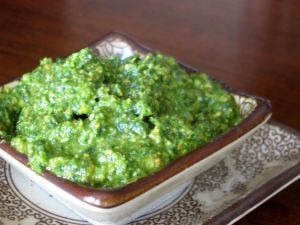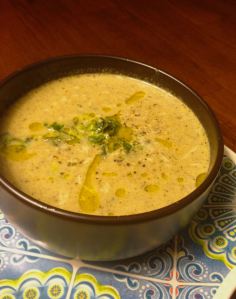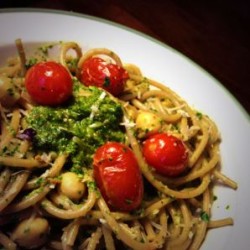Sunday, June 9, 2013
This post is dedicated to a few of my Facebook fans who asked me for the recipe after seeing a photo of Friday’s night’s supper. To stay in the loop on the latest food and nutrition news (and the occasional blog post recipe on Cooking & Eating the PK Way), please click here to like my prof Facebook page.
Actually, many people I know, but I’ve never understood. When its garlicky, herbaceous ingredients come together with fruity, velvety olive oil, the result is nothing less than sublime.
While I quite enjoy a traditional basil pesto, and you can watch my how-to video here, this versatile sauce can be made with many different combinations of herbs and nuts to suit the season, as well as your palate. Today’s recipe came about for three reasons. First, pasta with parsley pesto was on the cover of this month’s Bon Appétit. Second, gorgeous parsley is currently available at my farmers’ market right now, not basil. I thus had a surplus of parsley in the fridge as well as some roasted pistachios in the pantry (the third reason). Next thing you know, I whipped up my own version of parsley pesto and used it in a few different dishes I’ll tell you about this coming week.
I must confess that as I just threw this recipe together I did not take down precise quantities when I made it. (Here’s my philosophy on recipes.) That said, making pesto is super easy, there are tons of recipes on the web, and you should make it your own. Basic pesto recipes include herbs, nuts, olive oil, and cheese seasoned with freshly ground black pepper; vegan versions can omit the cheese with good effect (see below).
Parsley Pistachio Pesto
All You Need is Five Minutes and a Food Processor
Sure, you can use the traditional mortar and pestle if you’re feeling frisky, else take out my favorite appliance and you’ll be eating freshly-made pesto in a few minutes’ time.
What I did—all quantities are rough approximations—was start by chopping 1/2 cup roasted unsalted pistachios in the food processor. (It’s noisy but works just fine.) I next added about 3-4 cups of chopped flat leaf parsley and 2 large cloves of garlic and repulsed the whole thing. With the food processor running, I poured in extra virgin olive oil until the pesto came together. I’m not sure how much I added, but it was about 1/2 cup, maybe less? Observe closely how the spread comes together as you slowly drizzle in the oil; it should not be too thin. (Note the viscosity in the photo.) Season with freshly ground black pepper and sample. I tasted at this point and said “Wow! This doesn’t even need cheese!”
But I added cheese, since I love it—not quite 1/4 cup of freshly grated parmigiana. Romano or another hard Italian cheese will also work.
I pulsed it up again and the flavor was wonderful but a bit too thick. Normally I’d just add some more olive oil but I performed a little pesto experiment by adding a few tablespoons of water to see if I could obtain the texture I wanted without compromising the taste. (Note: I’ve made pesto for years and never before tried this.)
Wondering why? Well, to be honest, making pesto is kind of expensive. The best result requires nuts and a lot of olive oil, both of which are costly; a good cheese increases the price tag. Recalling that fat is our most energy-dense macronutrient at 9 kcal/g, these ingredients are also very high in calories. Although most of the fat is heart-healthy, and I would never compromise on flavor—olive oil is a key ingredient in pesto—this test was worth a shot.
I’m thrilled to report this experiment was a resounding success. The water served to add a little thinness to the sauce and had no discernible effect on taste. I ended up adding a few tablespoons and was done.
I can not even tell you how excited I was about this pesto. I just kept on say “I can’t believe how amazing this is!” to myself. And, as you can see, the color is a more vibrant shade of green due to the combination of parsley and pistachios, another bonus.
I hope you love it!
—
Learn more about nutrition scientist and food personality Dr. P.K. Newby, and check out her newest book. You can also follow her on FB, where she is much more active than on this blog. Or, click here if you just want to ogle food porn featuring plant-based, globally-inspired cuisine.





